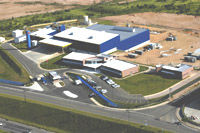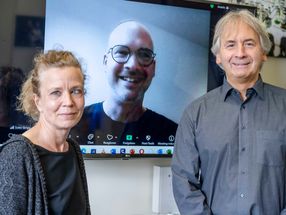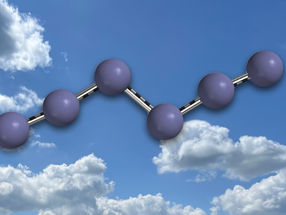Strange molecule in the sky cleans acid rain, scientists discover
Researchers have discovered an unusual molecule that is essential to the atmosphere's ability to break down pollutants, especially the compounds that cause acid rain. It's the unusual chemistry facilitated by this molecule, however, that will attract the most attention from scientists.
Marsha Lester, the University of Pennsylvania's Edmund J. Kahn Distinguished Professor, and Joseph Francisco, William E. Moore Distinguished Professor of Chemistry at Purdue University, found the molecule, which had puzzled and eluded scientists for more than 40 years.
Somewhat like a human body metabolizing food, the Earth's atmosphere has the ability to "burn," or oxidize pollutants, especially nitric oxides emitted from sources such as factories and automobiles. What doesn't get oxidized in the atmosphere falls back to Earth in the form of acid rain.
"The chemical details of how the atmosphere removes nitric acid have not been clear," Francisco says. "This gives us important insights into this process. Without that knowledge we really can't understand the conditions under which nitric acid is removed from the atmosphere."
Francisco says the discovery will allow scientists to better model how pollutants react in the atmosphere and to predict potential outcomes.
"This becomes important in emerging industrial nations such as China, India and Brazil where there are automobiles and factories that are unregulated," Francisco says. "This chemistry will give us insight into the extent that acid rain will be a future concern."
Lester says the molecule had been theorized by atmospheric chemists for 40 years and that she and Francisco had pursued it for the past several years. What makes the molecule so unusual is its two hydrogen bonds, which are similar to those found in water. The new atmospheric molecule has two hydrogen bonds, which allows it to form a six-sided ring structure. Hydrogen bonds are usually weaker than the normal bonds between atoms in a molecule, which are known as covalent bonds. In fact, covalent bonds are 20 times stronger than hydrogen bonds. But in this case, these two hydrogen bonds are strong enough to affect atmospheric chemistry, Francisco says.
"The reaction involving this molecule proceeds faster as you go to lower temperatures, which is the opposite of most chemical reactions," Lester says. "The rate of reaction also changes depending on the atmospheric pressure, and most reactions don't depend on external pressure. The molecule also exhibits unusual quantum properties."
Lester says the unusual properties prevented scientists from being able to model the reaction for so long.
The breakthrough was enabled by laser-based laboratory techniques at the University of Pennsylvania and the supercomputing resources available at Purdue, Francisco says. The computation was done on an SGI Altix supercomputer operated by the Office of Information Technology at Purdue.
"The key is knowing where to look and how to identify new chemical entities, and with the computing resources we have at Purdue we can help identify processes to within experimental uncertainty," he says. "We couldn't have done this without the supercomputing power that we have available."
Original publication: Bridget A. O'Donnell, Eunice X. J. Li, Marsha I. Lester and Joseph S. Francisco; "Special Feature: Spectroscopic identification and stability of the intermediate in the OH + HONO2 reaction"; Proceedings of the National Academy of Science 2008.
Most read news
Other news from the department science

Get the chemical industry in your inbox
By submitting this form you agree that LUMITOS AG will send you the newsletter(s) selected above by email. Your data will not be passed on to third parties. Your data will be stored and processed in accordance with our data protection regulations. LUMITOS may contact you by email for the purpose of advertising or market and opinion surveys. You can revoke your consent at any time without giving reasons to LUMITOS AG, Ernst-Augustin-Str. 2, 12489 Berlin, Germany or by e-mail at revoke@lumitos.com with effect for the future. In addition, each email contains a link to unsubscribe from the corresponding newsletter.




























































